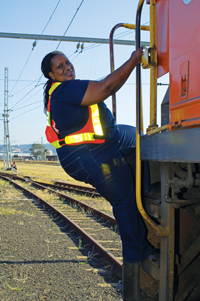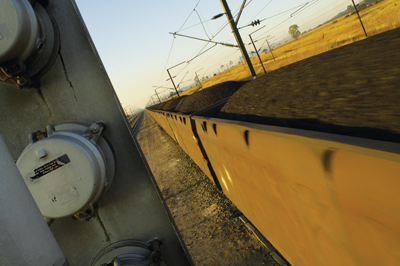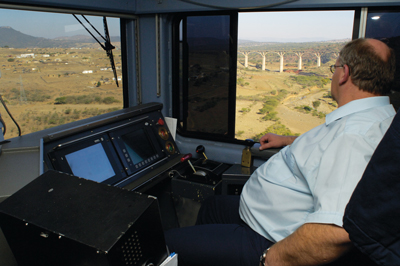SOUTH AFRICA’S TRANSNET IMPROVES LOGISTICS, DELIVERING MORE COAL TO RBCT
By Gavin du Venage, South African-based Editor
| A vessel takes on a load at the Richards Bay Coal Terminal; operators of the facility say Transnet has failed to provide adequate logistical infrastructure. (Photo credit: Pierre Crocquet) |
After years of pleading, South Africa’s coal industry is finally about to get its way — a much needed upgrade to the coal line that connects the interior to the main export terminal on the coast. Unfortunately, it may be too late.
South African state-owned logistics firm Transnet opted to name its mighty coal haul line the Songololo, the Zulu word for a “long black centipede.” The description is apt, as the Songololo coal line is perhaps the world’s longest Slinky, hauling 200 wagons through an area known since ancient times as “Valley of a Thousand Hills.” The track stretches 360 miles between the coalfields in Mpumalanga province to the port of Richards Bay, from where the product is shipped to clients around the world.
Impressive, though, as the line is, clients of the service have been far from happy. The Richards Bay Coal Terminal (RBCT) is the largest of its kind in the world, with a nameplate capacity of 91 million metric tons per year (mtpy). It has never come close to that. Last year, Transnet’s freight division managed around 70 million mt, one of its best years ever.
According to coal advisory firm XMP Consulting senior analyst Xavier Prevost, lack of capacity meant some of South Africa’s biggest customers were forced to look elsewhere to meet their requirements. By 2006, the European Union (EU) accounted for almost 90% of South Africa’s exports, but by last year only 27% of the country’s production was headed for Europe.
“We lost our main market and Colombia took it,” said Prevost. “Although, at the same time, we did start exporting more to the Pacific Rim, the loss of the EU market made a big impact in revenue to the industry. We could say the good standing our coal exports enjoyed — quality and reliability — went with it.”
A spokesman for Transnet declined to comment, citing mandatory corporate reporting rules that prohibit public statements during the closed period in a run-up to announcing annual results.
RBCT is privately held by a consortium of South Africa’s biggest coal producers, including Anglo American, BHP Billiton and Exxaro. They have argued that Transnet has not kept up with potential demand, while at the same time using its government-granted monopoly to keep private players out of the long-haul rail logistics market.
 |
| A driver boards a locomotive at Vryheid rail yard, where the Songololo coal line begins its journey to the coast. (Photo credit: Pierre Crocquet) |
“The reality is that Transnet Freight Rail’s rail capacity does not even match the current port capacity of 91 million mtpy,” BHP Billiton said in a statement earlier this year.
After years of often acrimonious exchanges between the coal companies and the rail operator, Transnet appears ready to move and has committed $20 billion to an overhaul of its freight operations. Already, it appears to be paying off.
Last July, Transnet introduced Class 19E locomotives — part of a 110-loco order — that can run on both alternating current and direct current overhead power lines. A quirk of the line is that the first half from the coalfields requires direct current traction, while the latter stretch to Richards Bay necessitated alternating current locomotives. This meant a time delay as locos were switched over at Ermelo, more or less in the center of the line.
Each train hauls 200 jumbo wagons of 82 mt each, almost 16,400 mt in total. The length of a train is nearly 2.4 miles. Anyone getting caught at a railway crossing as the train chugs past at nearly 50 miles per hour will have a tedious wait until it passes. The locomotives also have regenerative breaking, and Transnet is in talks with South Africa’s power utility Eskom to sell excess power — as much as 38 megawatts per train — back to the grid.
Transnet says it isn’t finished yet. In April, it doubled the number of trains from four a day to eight. The medium-term plan was to get 15 to 18 Songololos moving every day, and it hopes to add at least 10 million mt of delivered coal to RBCT within a year.
Transnet’s projections are that the line capacity will rise to 98 million in 2018-2019, by which time it will also be looking to complete an extension to Botswana, in the north.
Last year Siyabonga Gama, CEO of Transnet Freight Rail, said that a 65-mile heavy‐haul coal rail link between two countries will commence construction in 2015. Transnet has already set aside $3.7 billion for the extension, Gama noted, which will also traverse the Waterberg, South Africa’s largely unexploited northwest region that has around 75 billion mt of recoverable coal reserves.
Transnet already freights insignificant quantities of coal from Botswana, but the new extension is expected to carry between 40 to 80 million mtpy.
However, the rail provider may have trouble reaching its overall targets that amount collectively to as much as 110 million mtpy, according to Prevost. “While it could achieve those tonnages, maybe in five or seven years, coal production, especially of the quality required for export, is missing,” Prevost said.
“When we desperately needed more rail, it wasn’t there. Now it could be too late, as not only are we suffering from lack of capital investment, but the whole seaborne coal trade has been affected by a glut that has moved prices to such extreme low levels that many mines — in the USA, Australia and Indonesia — have become marginal and have to close down.”
Add to that the climate of regulatory uncertainty emanating from the country’s Department of Mineral Affairs, which is reportedly mulling the declaration of coal as a “strategic asset” to restrict exports, and the outlook for new investment is grim. “The forecast for the next five and 10 years do not show any promise,” Prevost added.
 |
| Trains must pull up to 200 wagons each along the coal line that feeds South Africa’s export market. (Photo credit: Pierre Crocquet) |
Nor will Transnet have the field all to itself for much longer. Brazil’s Vale is developing coal deposits in neighboring Mozambique and has budgeted $4.5 billion for a railway line and a port on the country’s east coast, intending to export 22 million mt within three years, Bloomberg has reported.
Transnet could also face a competitor for its planned Botswana-Waterberg link. In April, the governments of Namibia and Botswana said the two would commence a long-cherished project to build a 900-mile line, the Trans-Kalahari. The line will link landlocked Botswana to the port of Walvis Bay on Namibia’s Atlantic coastline — ideally placed to export to Europe.
The route will cost an estimated $10 billion to build, making it one of the largest civil construction projects either nation has ever contemplated.
“There is more than enough coal in Botswana to make a Trans-Kalahari line work,” said Alan Sproule, director of project finance, advisory and infrastructure finance at Standard Chartered Merchant Bank. Botswana’s Department of Geological Surveys puts reserves at 210 billion mt, and the country is eager to diversify away from its heavy dependency on diamonds for exports. The lack of rail capacity has been a major impediment to developing coal exports.
Sproule warned, though, that the proposed Namibia-Botswana line needs to be developed at a cost that allows coal exports to be competitive; “this will be difficult to achieve given the length of track that has to be developed over a greenfield route,” he said.
He noted that such a project would depend on a major backer with a strong balance sheet and one who has a large commitment in the Botswana coalfields to take on the debt risk and drive its development.
It would also need support from the respective governments, such as subsidies, to make the project viable, or through contractual commitments to ensure protection of lender rights. Should these hurdles be overcome, the case for an alternative line is compelling.
 |
| The Songololo coal trains move through the Valley of a Thousand Hills, a topographical roller coaster. (Photo credit: Pierre Crocquet) |
“The reason for the competing line is that the Transnet coal line is never going to meet the demand in Botswana,” Sproule added. “The Namibia link has the potential to export more than 50 million mtpy — the Transnet solution will only manage to service a small percentage of that given the existing demand from South African miners and the capacity constraints at Richard’s Bay and Matola.”
Another consideration is that South Africa’s ability to manage large-scale projects has been hit-and-miss in the past.
“We’ve had some good surprises and bad surprises,” said Andrew Lane, energy and resources leader at Deloitte Africa. “The 2010 World Cup was a good surprise,” Lane said in reference to the nearly $10 billion project to host the tournament. “But we’ve also had some bad surprises, such as Medupi,” he noted, a call on state power utility Eskom’s two-year-behind schedule project to build the world’s biggest dry-fired coal power plant.
Transnet has also seen an exodus of senior management with experience in running projects. “Success of this plan will really depend on the people Transnet throws at it. If they bring in the right managers it can be done,” Lane concluded.




